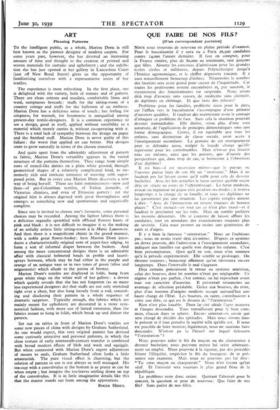ART
Pleasing Patterns To the intelligent public, as a whole, Marion Dorn is still best known as the pioneer designer of modem carpets. For some years past, however, she has devoted an increasing amount of time and thought to the creation of printed and woven materials for curtains and upholstery ; and the exhibi- tion she has just opened at her gallery in Lancashire Court (just off New Bond Street) gives us the opportunity of familiarising ourselves with a representative series of her textiles.
The experience is most refreshing. In the first place, one is delighted with the variety, both of texture and of pattern. There are clean cottons and muslins, comfortable linen and wool, sumptuous brocade: stuffs for the sitting-room of a country cottage and stuffs for the ballroom of an embassy. Marion Dom has a delicious sense of touch ; her feeling for crispness, for warmth, for lissomness is unequalled among present-day textile-designers. It is a common experience to see a design, good in itself, applied without sensibility to a material which merely carries it, without co-operating with it. There is a total lack of sympathy between the design on paper and the finished stuff. Marion Dorn is never guilty of this failure: the worst that applied art can betray. Her designs scan to grow naturally in terms of the chosen material.
And quite apart from the admirable adjustment of pattern to fabric, Marion Dom's versatility appears in the varied structure of the patterns themselves. They range from simple rows of stencil-like daisies on a plain white ground, through geometrical shapes of a relatively complicated kind, to im- mensely rich and intricate mixtures of weaving with super- posed print. But in every case Marion Dorn discovers a new way of being herself. There are faint reminiscences—now and then—of pre-Colombian textiles, of Italian damasks, of Victorian chintzes, and even of Etruscan pottery : yet the original hint is always digested with great thoroughness and emerges as something new and spontaneous and organically complete.
Since one is invited to choose one's favourite, some personal choices may be recorded. Among the lighter fabrics there is a delicious organdie sprinkled with offhand flowery knots of pink and black : it is not difficult to imagine it as the making of an artfully artless little sitting-room a la Marie Laurencin. And then there is a magnificent chintz in the grand manner, with a noble great flower-basket: here Marion Dorn intro- duces a characteristically original note of paper-lace edging, to fotm a sort of informal diaper between the baskets. And among the more concentrated designs there is an admirable affair with classical helmeted heads in profile and laurel- sprays between, which may be had either in the purple and orange of an antique vase or in two tones of green (olive and mignonette) which allude to the patina of bronze.
Marion Dorn's textiles are displayed in folds, hung from great white rings on the white wall of her gallery : a device which quietly reveals that she has not forgotten (as so many less experienced designers do) that stuffs are not only stretched tight over a chair, but also hang loosely from a rod, conceal- ing and disclosing their pattern in a whole sequence of dramatic surprises. Typically enough, the fabrics which are mainly meant for upholstery are decorated in a more sym- metrical fashion, with more use of lateral extension, than the fabrics meant to hang in folds, which break up and.distort the pattern.
Set out on tables in front of Marion Dorn's textiles are some new pieces of china with designs by Graham Sutherland. As one would expect, this very original painter has devised some curiously attractive and personal patterns, in which the dose texture of early nineteenth-century transfer is combined with broad modern effects of blob and wash and squiggle. But when contrasted with Marion Dorn's expert adjustment of means to ends, Graham Sutherland often looks a little amateurish. The pure visual effect is charming, but the relation of pattern to use is not always so well managed. His tea-cup with a convolvulus at the bottom is as pretty as can be . when empty ; but imagine the tea-leaves settling down on top of the convolvulus. It is in little imaginative details like this that the master stands out from among the apprentices. ROGER Hnixs.










































 Previous page
Previous page